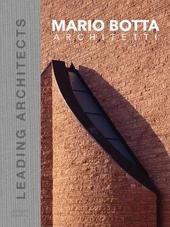
|
Mario Botta Architetti: Leading Architects
Hardback
Main Details
Description
We recognise Mario Botta's buildings for their strong presence. His architecture is not ephemeral. It shapes the mass firmly and precisely. It touches the ground with self-reliance. A building by Mario Botta is an autonomous object. It comprises an ordered world of its own make. It is standing in dialogue with the urban tissue, but it establishes its own order as if it aims at differentiation instead of integration. Architectural order represents the core of his personal idiom. It is a well structured, compositional order which organises everything into a whole, as an underlying thread that connects and brings together houses on the mountains to museums and churches, banks and commercial buildings to buildings on the ground and buildings underground, different buildings at different places in time. The themes that underlie Mario Botta's architecture are ties that connect and spines that support, common threads that bind one building to the next. His architecture is one of mass. It is then of no surprise that mass is the first thing to be defined and ordered, in his creative process. The volume of his buildings is mostly composed by one or more primary solids. Volume is thus an a-priori for Botta. It is conceived beforehand, the starting point to the adventure of architectural design. SELLING POINTS: . Showcases Mario Botta's portfolio of projects and contemporary design talents in stunning full-colour photography, with detailed plans and drawings and comprehensive profile descriptions . Celebrates almost 40 works of this prolific architect, and is a superb compendium to IMAGES' highly successful Leading Architects Series . Profiles the insight into the influences of this firm and its practice, while capturing its vision for the future of design, emerging trends and influences that shapes its work 400 colour
Author Biography
After serving an apprenticeship in Lugano, Italy, Mario Botta first attended the Art College in Milan and then studied at the University Institute of Architecture in Venice. Directed by Carlo Scarpa and Giuseppe Mazzariol he received his professional degree in 1969. While studying in Venice, he had the opportunity to meet and work for Le Corbusier and Louis I. Kahn. Botta's professional career began in 1970 in Lugano. Known for his single-family houses in Ticino, the place of his birth, his work now encompasses many other building types, including schools, banks, administration buildings, libraries, museums, and sacred buildings. Botta also teaches extensively, and runs lectures, seminars and courses in architectural schools in Europe, Asia, North and South America. He served as visiting professor at the Ecole Polytechnique Federale in Lausanne in 1976, and at the Yale School of Architecture, New Haven, United States in 1987 and since 1983 he is Professor of the Swiss Polytechnic Schools. From 1982 to 1987 he was a member of the Swiss federal commission of fine arts. Since the beginning of his career, Botta's work has been recognised internationally and honoured with prestigious awards. In 1996 Botta became one of the founders of the Academy of Architecture of the Universita della Svizzera Italiana in Mendrisio, Switzerland. Today he continues to teach there as a Professor, and he held the directorship from 2002 to 2003, and 2011 to 2013. By teaching at the Academy of Architecture, his role as chairman of the award jury of the BSI Architectural Foundation and his current commitment in the realisation of the Theatre of Architecture, Botta is able to impart his knowledge of a profession that is, first and foremost, his passion.
|